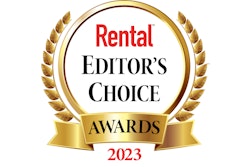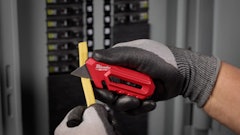
*This content is sponsored by Propane Education & Research Council (PERC)*
The equipment rental industry has gone through nearly four years of upheaval but held steadfastly to expansion. With a 6 percent annual growth rate projected through 2030, that’s “surprising resilience in an economy that is not that strong,” according to analysts.
That growth has been hard-earned, says Josh Nickell, vice president, equipment segment, at the American Rental Association (ARA). With more than 50% of equipment now rented, not owned, ARA’s 5,700 member companies, many of which are small multigenerational family businesses with less than 5 locations, have had to scramble to address big picture (and big cost) issues.
The industry meets this month for The ARA Show, a staple of rental companies since 1956, and it’s sure to include conversations around new technology like alternative fuels. From this springboard, rental businesses will be planning for success in 2024. And that includes taking a good hard look at total cost of ownership, and which pieces of equipment offer the best overall value from beginning to end of life.
“The unique thing about rental equipment, rather than the contractor owning it, is people don't take as good care of it. One way to solve that is to go with a simplified fuel system, like propane. It’s a closed fueling system without any corrosion or breakdown of fuel when stored, which is great for rental companies,” says Jim Bunsey, senior manager of safety and compliance for Propane Education & Research Council (PERC).
Key Factors in Total Cost of Ownership
It’s hard to directly calculate wear/tear or equipment abuse by renters, but there are plenty of things you can calculate. Certainly, standardized metrics like dollar and time utilization are something “we can all agree on,” Nickell says, but some portions of the total cost of ownership should be up there, too. Here’s where Nickell and Bunsey recommend you start.
Purchase Price
The pandemic affected equipment costs, new and used. According to Nickell, rental businesses are seeing that new equipment with 2020/2021 model years is not holding value as well as their counterparts, which he attributes to supply chain disruption, labor shortages and other unusual circumstances at the height of the crisis. Meanwhile, used equipment of all model years bought in 2020/2021 saw their prices artificially inflated, which changes your value at the end of the total cost of ownership.
Equipment Life
Most rental businesses are financing larger equipment over five years or less and smaller equipment over three years or less. The average fleet age is 3.5-4 years old and the oldest equipment is usually under 7 years. Leasing in a rental business is less common, but typically comes in the form of the $1 buyout lease, which is more like a finance program. That means, “it’s about finding that sweet spot” when the equipment is paid off but still functions well with minimal downtime and without major maintenance needed.
Preventive Maintenance
The cost of preventive maintenance, however, should be one of the first things you calculate, like oil changes, tire rotations and replacement and other standard work. Propane systems can simplify some of that engine work, Bunsey says. Look at the big picture projects that take your team's time. The newer the model year of your equipment, the more complex the telematics and onboard technology is likely to be, affecting labor cost.
Fuel Costs
When Bunsey works with rental businesses, the first thing he asks is: Are you controlling your fuel costs? When providing gasoline equipment, you fill it up before renting it out. That adds up. Propane-powered equipment, on the other hand, can pay for itself. A propane supplier will install a storage tank, typically at little to no cost, and fill it on site, so equipment can be fueled right there. Then the rental company can also start to sell propane by the gallon. ”We're actually making money from renting the equipment and also fueling the equipment,” Bunsey explains. Nickell adds that fuel costs vary widely and impact your profitability but aren’t specific to the equipment – unless you look at fuel economy and conversions to sources like propane.
Conversion
Fuel systems exposed to oxygen and left with fuel in them on the lot will also need to be part of the maintenance discussion. Forklifts, woodchippers and other equipment, however, can easily be converted to propane, a closed fueling system that won’t have corrosion or breakdown, even if they sit unused. A small upfront cost could be saved in the refurbishment years later.
Refurbishment
Customers care about how good their rental equipment runs – and looks. Nickell recalls one customer chewing him out over a piece of equipment that wasn’t in perfect shape. “Accidentally, we gave them that same piece of equipment a couple of months later after we had sanded it down, repainted it, really hadn't done any maintenance work to it other than make it look new again. And they called me to thank me for sending them such a great piece of equipment!” Perception in rental is important when you're talking about that total cost of ownership. At five years old, equipment will need to be refurbished inside and out to extend rentable life by two to five years.
Preparing for the future
Looking ahead, more rental companies will want to upgrade their fleets with equipment powered by propane, electric or other sustainable alternatives. Replacement costs won’t be as straightforward as the past. Nickell says that also goes for preparing for new trends. A couple of ones Nickell says he encourages rental companies to consider are:
- Tracked units are becoming more popular than wheeled units.
- The full-size backhoe is being replaced with the mini excavator and the skid steer as the better solution for many projects.
Overall rental companies are primed for success in 2024.
“What a rental company is best at is being a great fleet manager and making those decisions of cost of ownership, when to buy, when to sell, what to buy, what to sell. And we usually have a strong fleet mix,” Nickell explains. “Whereas a contractor usually has to buy a piece of equipment that does every job or as many jobs as possible, an equipment rental company has the ability and opportunity to manage that demand and share assets between multiple contractors, which means that they can have electric, they can have the propane and they can have the diesel.”
Sidebar: What NOT To Calculate in Total Cost of Ownership
A few things that can add up but are just too cumbersome to include, Nickell says, are:
- Shipping & Logistics
- Interest Rates
- Supply Chain Costs Upstream
- Wreck or Accident Maintenance
- Wash Time
- Load/Unload Time



















